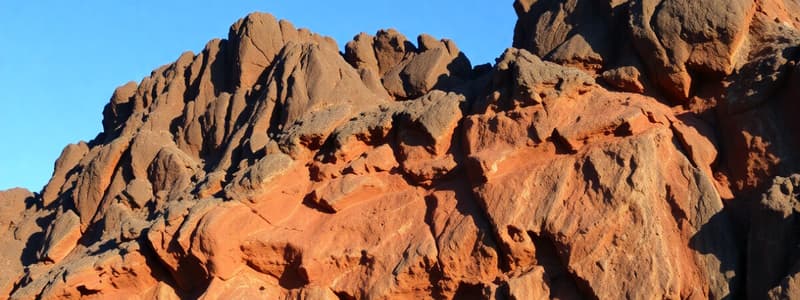Podcast
Questions and Answers
What is the primary constituent of igneous rocks?
What is the primary constituent of igneous rocks?
- Silicon dioxide (SiO₂) (correct)
- Aluminum oxide (Al₂O₃)
- Magnesium oxide (MgO)
- Iron oxides (Fe)
Which group of igneous rocks contains less than 45% silica?
Which group of igneous rocks contains less than 45% silica?
- Acid Rocks
- Intermediate Rocks
- Basic Rocks
- Ultrabasic Rocks (correct)
Which characteristic is typically associated with acidic igneous rocks?
Which characteristic is typically associated with acidic igneous rocks?
- Light-colored with low specific gravity (correct)
- Rich in calcium and sodium
- Dark-colored with high specific gravity
- Rich in iron and magnesium
What type of magma is characterized by being rich in calcium, magnesium, and iron?
What type of magma is characterized by being rich in calcium, magnesium, and iron?
Which of the following minerals is typically found in basic igneous rocks?
Which of the following minerals is typically found in basic igneous rocks?
What process transforms sedimentary rocks into metamorphic rocks?
What process transforms sedimentary rocks into metamorphic rocks?
Which of the following rocks is an example of an acid rock?
Which of the following rocks is an example of an acid rock?
Approximately what percentage of the Earth's crust is composed of igneous rocks?
Approximately what percentage of the Earth's crust is composed of igneous rocks?
Flashcards are hidden until you start studying
Study Notes
Rock Cycle
- The rock cycle demonstrates the continuous transformation of igneous, sedimentary, and metamorphic rocks.
- Erosion creates sediment that is transported and deposited, forming sedimentary rocks.
- Sedimentary rocks are transformed into metamorphic rocks under high temperature and pressure.
- Metamorphic rocks melt at great depths, creating magma.
- Magma rising to the Earth's surface cools and solidifies, forming igneous rocks.
- Weathering and erosion of igneous rocks restarts the cycle.
Igneous Rocks
- Igneous rocks constitute approximately 90% of the Earth's crust.
- They form from the cooling and solidification of magma, a molten silicate melt.
- Magma originates from deep within the Earth and primarily consists of oxygen (O), silicon (Si), aluminum (Al), iron (Fe), calcium (Ca), magnesium (Mg), sodium (Na), and potassium (K).
- When magma reaches the Earth's surface, it is called lava and loses its gases.
Chemical Composition
- Igneous rocks have a limited range of chemical compositions.
- Silicon dioxide (SiO₂) is the primary constituent, ranging from 40% to 75% by weight.
- Other significant oxides include aluminum oxide (Al₂O₃), calcium oxide (CaO), magnesium oxide (MgO), and iron oxides (Fe), typically comprising 10-20% each.
Acid and Basic Rocks
- The chemical composition of igneous rocks reflects the composition of the magma from which they formed.
- Magma can be broadly classified as acidic or basic.
- Acidic magma is rich in silicon (Si), sodium (Na), and potassium (K), but poor in calcium (Ca), magnesium (Mg), and iron (Fe).
- Basic magma is rich in calcium (Ca), magnesium (Mg), and iron (Fe), but poor in silicon (Si), sodium (Na), and potassium (K).
Classification of Igneous Rocks based on Silica Percentage
- Igneous rocks are categorized based on their silica content:
- Ultrabasic Rocks: Less than 45% silica (e.g., peridotite)
- Basic Rocks: 45% to 55% silica (e.g., gabbro and basalt)
- Intermediate Rocks: 55% to 65% silica (e.g., diorite)
- Acid Rocks: More than 65% silica (e.g., granite)
General Characteristics
- Acidic igneous rocks are typically light-colored, have a low specific gravity (around 2.7), and contain minerals like quartz and alkali feldspar (felsic rocks).
- Basic igneous rocks are often dark-colored (often black), have a relatively high specific gravity (around 3.2), and mainly contain silica-poor minerals such as olivine, pyroxene, hornblende, or biotite (mafic rocks), with little or no quartz.
- Basalt is an example of a basic rock.
Studying That Suits You
Use AI to generate personalized quizzes and flashcards to suit your learning preferences.




